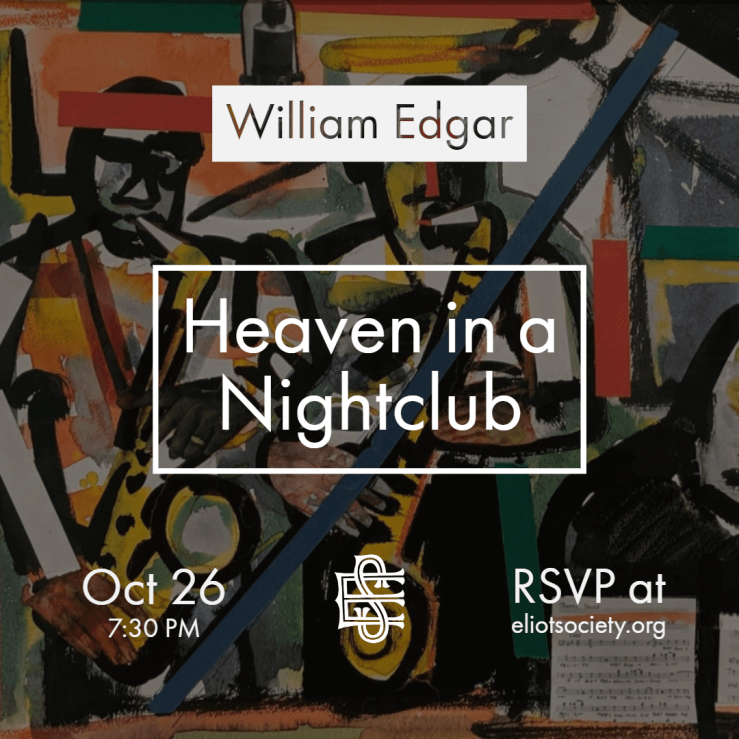If you live in the Baltimore-Washington area, I hope I’ll see you at one or all of the Eliot Society events this fall! For “Heaven in a Nightclub” on October 26, we’re bringing in jazz pianist Bill Edgar from Philly to give a combo concert-lecture highlighting the spiritual roots of African American music. “The Art of Feasting” will kick off our Living Room Series on November 8, as Heidi Stevens, who teaches art at a local K-12 classical Christian school, will guide us in looking most especially at food table still life paintings from the Dutch Golden Age. On December 13, we’ll gather together again for more food and drinks and to collectively read Charles Dickens’s A Christmas Carol in character. Reserve your spots at https://eliotsociety.org/!
+++
CONFERENCE: The 2019 Madeleine L’Engle Conference: Walking on Water: I just caught wind of this great opportunity taking place November 15–16 at All Angels’ Church in New York City, where L’Engle was a member. “In celebration of Madeleine L’Engle’s centenary year, this inaugural conference brings together a diverse group of artists and seekers to explore, challenge, and deepen our creative lives. . . . The conference has a combination of keynote addresses, panel discussions, and workshops that will be of interest to people across faith traditions who are interested how faith and art inform each other. There will also be sessions on the works and influence of Madeleine L’Engle, and opportunities for alumni of her workshops to reunite and share stories.”
The conference is co-directed by Sarah Arthur, author of A Light So Lovely: The Spiritual Legacy of Madeleine L’Engle (book trailer below), and Brian Allain, owner of Writing for Your Life. The headline speaker is children’s author Katherine Paterson (Bridge to Terabithia; The Great Gilly Hopkins).
+++
LECTURE: “Defining the New” by Roger Lowther: In this sixteen-minute talk from the Community Arts Tokyo International Arts Festival in June [previously], Roger Lowther draws out the festival’s theme of “All Things New” through piano music—namely, Bach’s Prelude in C Major and Chopin’s “Raindrop” Prelude. Both start out prettily, move through a section of dissonance, and then find a new and richer beginning on the other side. “In this world full of sadness,” says Lowther, “we can find a new beginning.” He tells the story of a church piano in Kamaishi City that took on water in the March 11, 2011, tsunami. Rather than throw it out as beyond repair, the church spent much time, effort, and money fixing it up, even though it would have been much easier to just buy a new one. In doing so, they demonstrated the gospel hope of “all things made new.”
Lowther and his wife, Abi, are the directors of the MAKE Collective, “a network of artists [under Mission to the World] who, like Bezalel, have been called by name, by God, and have been filled with the Spirit of God in wisdom, understanding, knowledge, and all kinds of craftsmanship (Exodus 31:2-3). They have embraced their gifts and accepted their unique opportunity and responsibility that the holistic, prophetic, and pastoral expression of those gifts affords in their participation in the evangelical/cultural mandate—God’s reconciliation of all things to Himself, in the context of global church planting movements.” Their values include listening, questioning, experimenting, challenging, generosity, transparency, inclusion, and excellence.
I had lunch with the founder of MAKE, Berenice Rarig [previously], last year and am always encouraged by the thoughtful content of the organization’s bimonthly e-newsletter—some of which can be viewed on their new website, https://themakecollective.org/. Their September newsletter pointed me to a new video of five missionary artists, including the Lowthers, discussing art as community building, as storytelling, and as therapy, as well as beauty in brokenness:
VIDEO: “Can Arts Also Be Missions?” [transcript]
+++
PLAYLIST: Philip Majorins of Liturgy Letter curated an excellent playlist of various settings and performances of the Lord’s Prayer by artists ranging from jazz greats Duke Ellington and Vince Guaraldi to gospelers Aretha Franklin and the Staples Singers to contemporary folk rockers Sandra McCracken and Gungor to Serbian Orthodox singer Divna Ljubojević and even the Byzantine darkwave band Anastasis. And more!
+++
CROWDFUNDING CAMPAIGN: Earlier this year I participated in the Art Stations of the Cross pilgrimage/exhibition in Amsterdam. One of the stops was Mozes en Aäronkerk, which housed Masha Trebukova’s Anywhere, Anytime. This series of paintings on glossy magazine pages raises awareness of human suffering around the globe, providing visual prompts for prayer and action. The artist is seeking to reproduce the images in a standard print-book format for mass production, and she needs help funding the project. Donate at https://www.voordekunst.nl/projecten/9400-anywhere-anytime.











